Answers of Health Care 2022
VerifiedAdded on 2022/10/09
|9
|2223
|33
AI Summary
Contribute Materials
Your contribution can guide someone’s learning journey. Share your
documents today.
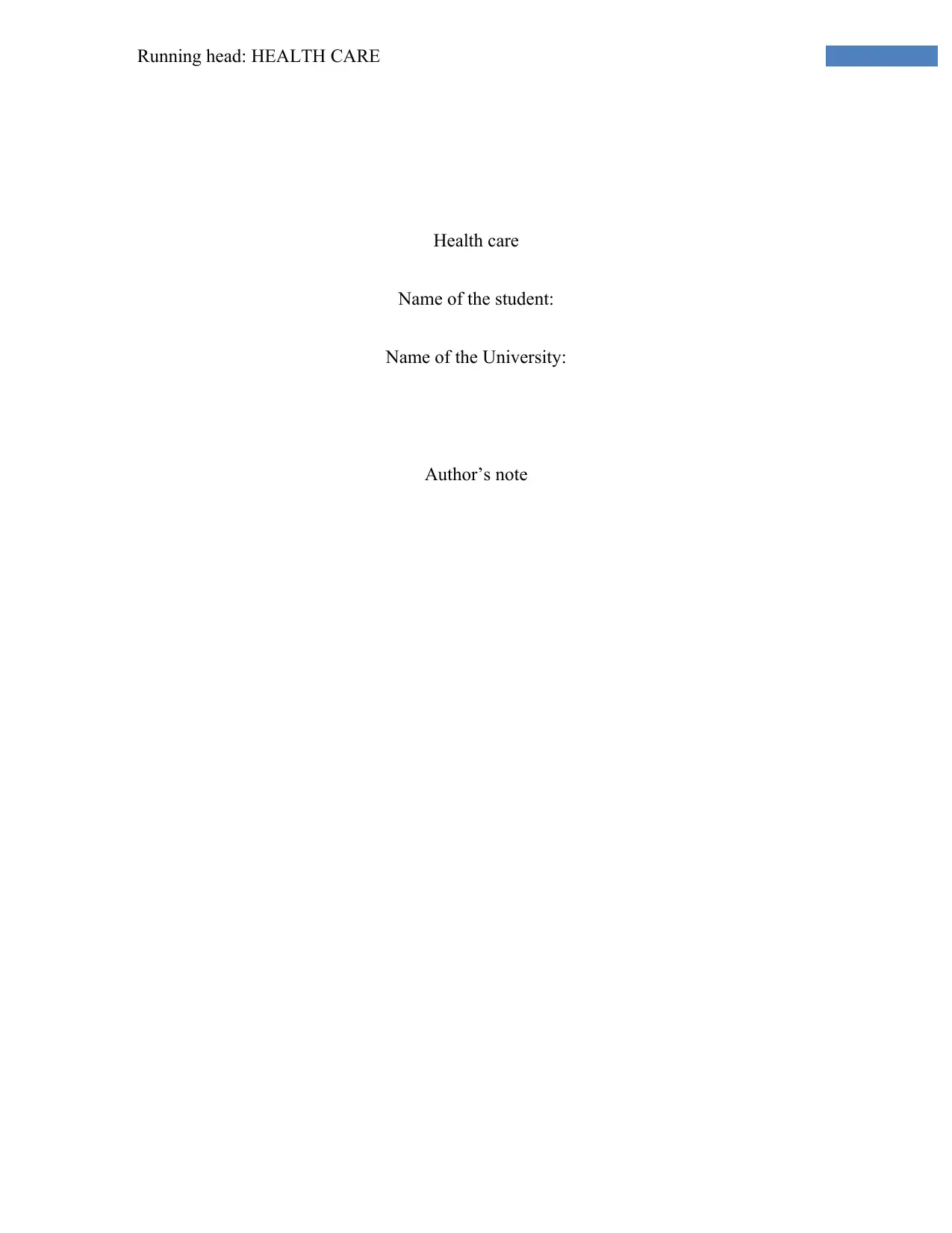
Running head: HEALTH CARE
Health care
Name of the student:
Name of the University:
Author’s note
Health care
Name of the student:
Name of the University:
Author’s note
Secure Best Marks with AI Grader
Need help grading? Try our AI Grader for instant feedback on your assignments.
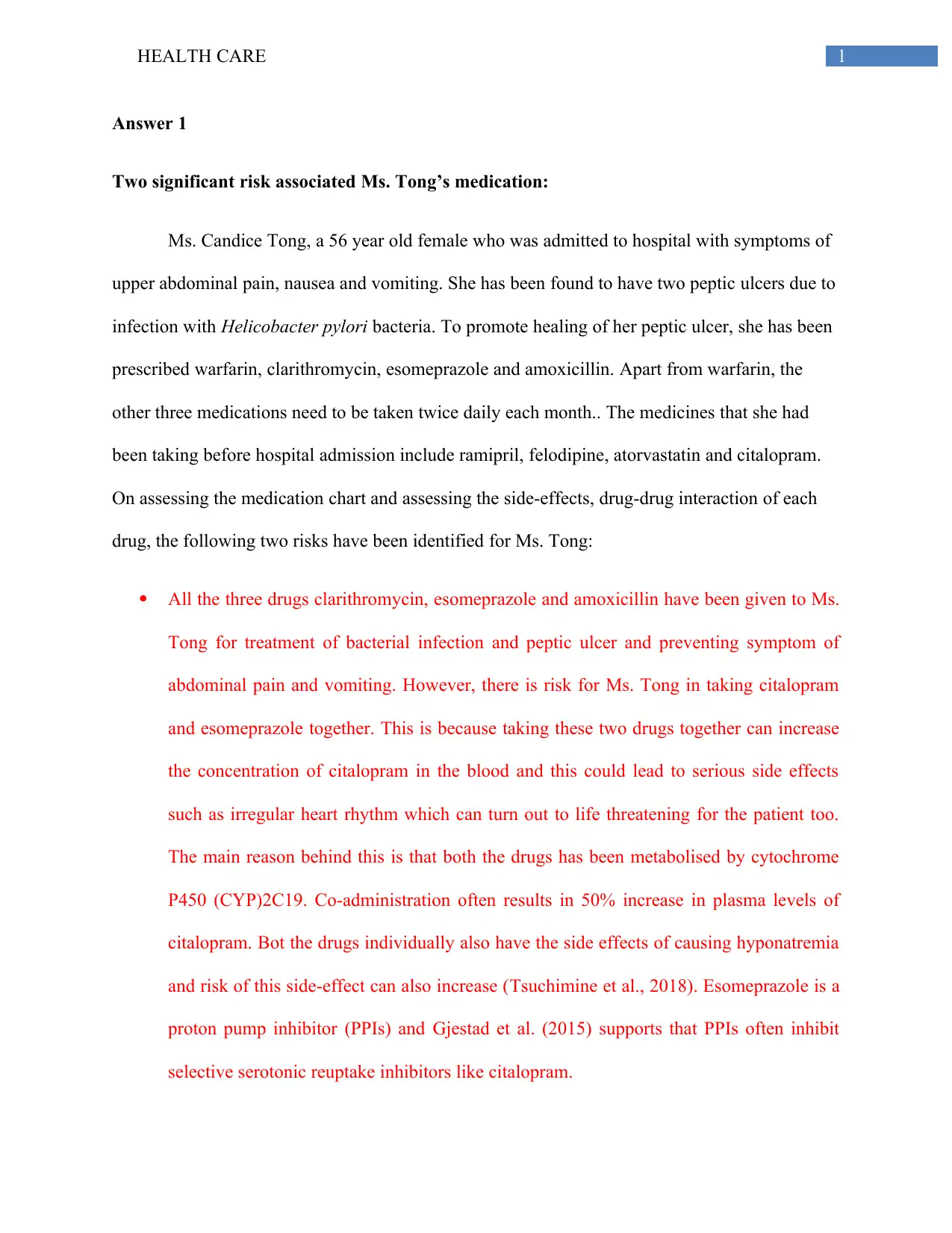
1HEALTH CARE
Answer 1
Two significant risk associated Ms. Tong’s medication:
Ms. Candice Tong, a 56 year old female who was admitted to hospital with symptoms of
upper abdominal pain, nausea and vomiting. She has been found to have two peptic ulcers due to
infection with Helicobacter pylori bacteria. To promote healing of her peptic ulcer, she has been
prescribed warfarin, clarithromycin, esomeprazole and amoxicillin. Apart from warfarin, the
other three medications need to be taken twice daily each month.. The medicines that she had
been taking before hospital admission include ramipril, felodipine, atorvastatin and citalopram.
On assessing the medication chart and assessing the side-effects, drug-drug interaction of each
drug, the following two risks have been identified for Ms. Tong:
All the three drugs clarithromycin, esomeprazole and amoxicillin have been given to Ms.
Tong for treatment of bacterial infection and peptic ulcer and preventing symptom of
abdominal pain and vomiting. However, there is risk for Ms. Tong in taking citalopram
and esomeprazole together. This is because taking these two drugs together can increase
the concentration of citalopram in the blood and this could lead to serious side effects
such as irregular heart rhythm which can turn out to life threatening for the patient too.
The main reason behind this is that both the drugs has been metabolised by cytochrome
P450 (CYP)2C19. Co-administration often results in 50% increase in plasma levels of
citalopram. Bot the drugs individually also have the side effects of causing hyponatremia
and risk of this side-effect can also increase (Tsuchimine et al., 2018). Esomeprazole is a
proton pump inhibitor (PPIs) and Gjestad et al. (2015) supports that PPIs often inhibit
selective serotonic reuptake inhibitors like citalopram.
Answer 1
Two significant risk associated Ms. Tong’s medication:
Ms. Candice Tong, a 56 year old female who was admitted to hospital with symptoms of
upper abdominal pain, nausea and vomiting. She has been found to have two peptic ulcers due to
infection with Helicobacter pylori bacteria. To promote healing of her peptic ulcer, she has been
prescribed warfarin, clarithromycin, esomeprazole and amoxicillin. Apart from warfarin, the
other three medications need to be taken twice daily each month.. The medicines that she had
been taking before hospital admission include ramipril, felodipine, atorvastatin and citalopram.
On assessing the medication chart and assessing the side-effects, drug-drug interaction of each
drug, the following two risks have been identified for Ms. Tong:
All the three drugs clarithromycin, esomeprazole and amoxicillin have been given to Ms.
Tong for treatment of bacterial infection and peptic ulcer and preventing symptom of
abdominal pain and vomiting. However, there is risk for Ms. Tong in taking citalopram
and esomeprazole together. This is because taking these two drugs together can increase
the concentration of citalopram in the blood and this could lead to serious side effects
such as irregular heart rhythm which can turn out to life threatening for the patient too.
The main reason behind this is that both the drugs has been metabolised by cytochrome
P450 (CYP)2C19. Co-administration often results in 50% increase in plasma levels of
citalopram. Bot the drugs individually also have the side effects of causing hyponatremia
and risk of this side-effect can also increase (Tsuchimine et al., 2018). Esomeprazole is a
proton pump inhibitor (PPIs) and Gjestad et al. (2015) supports that PPIs often inhibit
selective serotonic reuptake inhibitors like citalopram.
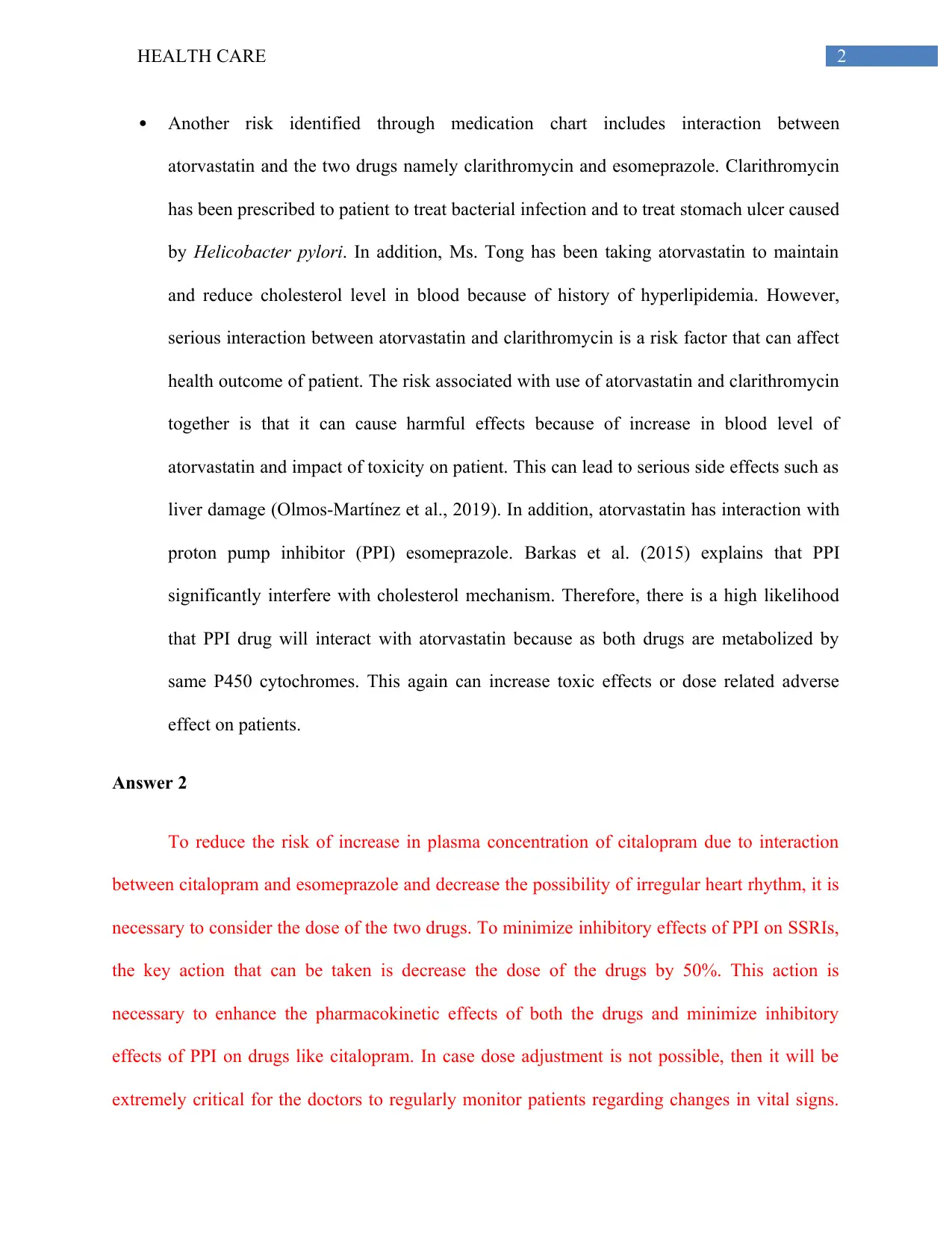
2HEALTH CARE
Another risk identified through medication chart includes interaction between
atorvastatin and the two drugs namely clarithromycin and esomeprazole. Clarithromycin
has been prescribed to patient to treat bacterial infection and to treat stomach ulcer caused
by Helicobacter pylori. In addition, Ms. Tong has been taking atorvastatin to maintain
and reduce cholesterol level in blood because of history of hyperlipidemia. However,
serious interaction between atorvastatin and clarithromycin is a risk factor that can affect
health outcome of patient. The risk associated with use of atorvastatin and clarithromycin
together is that it can cause harmful effects because of increase in blood level of
atorvastatin and impact of toxicity on patient. This can lead to serious side effects such as
liver damage (Olmos-Martínez et al., 2019). In addition, atorvastatin has interaction with
proton pump inhibitor (PPI) esomeprazole. Barkas et al. (2015) explains that PPI
significantly interfere with cholesterol mechanism. Therefore, there is a high likelihood
that PPI drug will interact with atorvastatin because as both drugs are metabolized by
same P450 cytochromes. This again can increase toxic effects or dose related adverse
effect on patients.
Answer 2
To reduce the risk of increase in plasma concentration of citalopram due to interaction
between citalopram and esomeprazole and decrease the possibility of irregular heart rhythm, it is
necessary to consider the dose of the two drugs. To minimize inhibitory effects of PPI on SSRIs,
the key action that can be taken is decrease the dose of the drugs by 50%. This action is
necessary to enhance the pharmacokinetic effects of both the drugs and minimize inhibitory
effects of PPI on drugs like citalopram. In case dose adjustment is not possible, then it will be
extremely critical for the doctors to regularly monitor patients regarding changes in vital signs.
Another risk identified through medication chart includes interaction between
atorvastatin and the two drugs namely clarithromycin and esomeprazole. Clarithromycin
has been prescribed to patient to treat bacterial infection and to treat stomach ulcer caused
by Helicobacter pylori. In addition, Ms. Tong has been taking atorvastatin to maintain
and reduce cholesterol level in blood because of history of hyperlipidemia. However,
serious interaction between atorvastatin and clarithromycin is a risk factor that can affect
health outcome of patient. The risk associated with use of atorvastatin and clarithromycin
together is that it can cause harmful effects because of increase in blood level of
atorvastatin and impact of toxicity on patient. This can lead to serious side effects such as
liver damage (Olmos-Martínez et al., 2019). In addition, atorvastatin has interaction with
proton pump inhibitor (PPI) esomeprazole. Barkas et al. (2015) explains that PPI
significantly interfere with cholesterol mechanism. Therefore, there is a high likelihood
that PPI drug will interact with atorvastatin because as both drugs are metabolized by
same P450 cytochromes. This again can increase toxic effects or dose related adverse
effect on patients.
Answer 2
To reduce the risk of increase in plasma concentration of citalopram due to interaction
between citalopram and esomeprazole and decrease the possibility of irregular heart rhythm, it is
necessary to consider the dose of the two drugs. To minimize inhibitory effects of PPI on SSRIs,
the key action that can be taken is decrease the dose of the drugs by 50%. This action is
necessary to enhance the pharmacokinetic effects of both the drugs and minimize inhibitory
effects of PPI on drugs like citalopram. In case dose adjustment is not possible, then it will be
extremely critical for the doctors to regularly monitor patients regarding changes in vital signs.
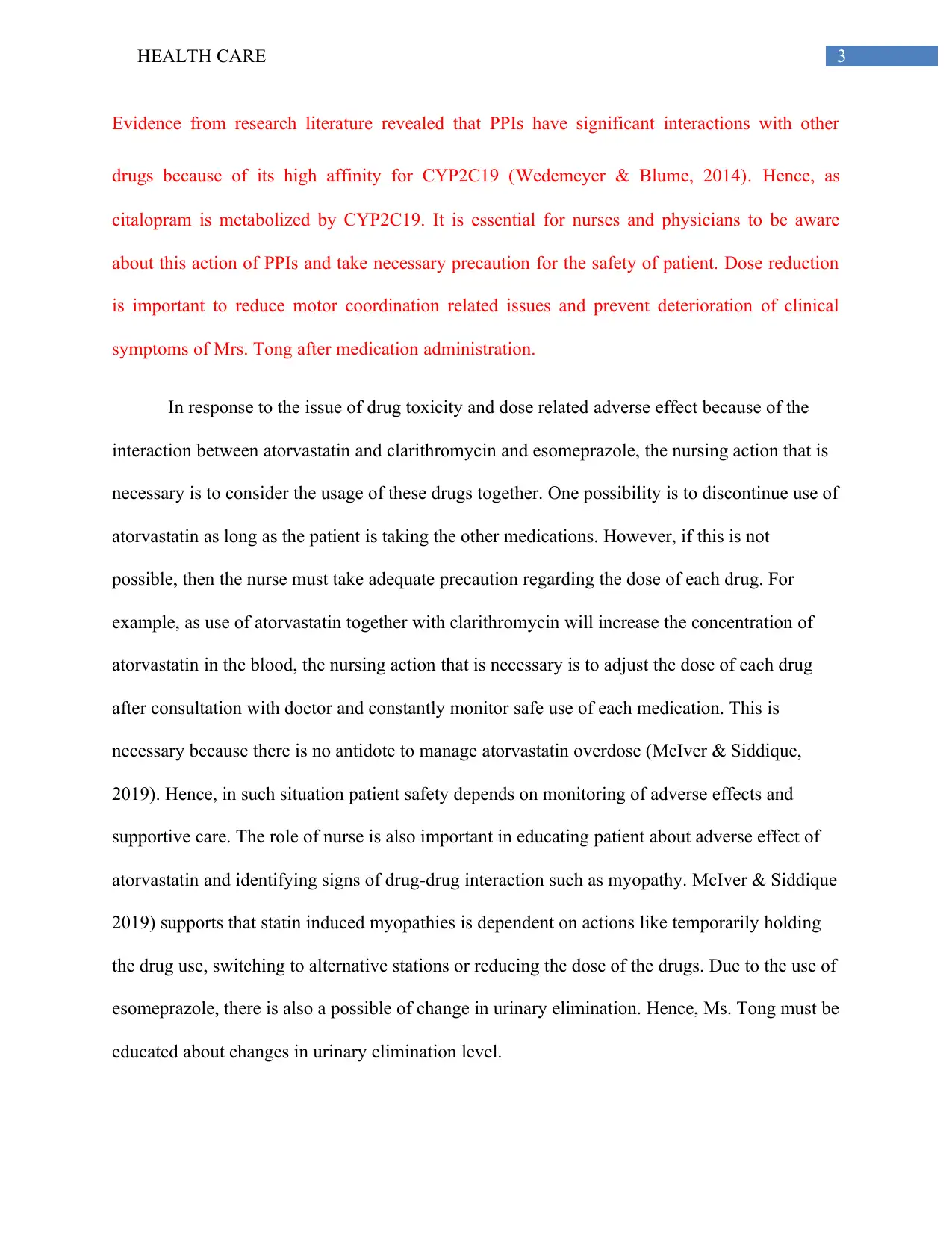
3HEALTH CARE
Evidence from research literature revealed that PPIs have significant interactions with other
drugs because of its high affinity for CYP2C19 (Wedemeyer & Blume, 2014). Hence, as
citalopram is metabolized by CYP2C19. It is essential for nurses and physicians to be aware
about this action of PPIs and take necessary precaution for the safety of patient. Dose reduction
is important to reduce motor coordination related issues and prevent deterioration of clinical
symptoms of Mrs. Tong after medication administration.
In response to the issue of drug toxicity and dose related adverse effect because of the
interaction between atorvastatin and clarithromycin and esomeprazole, the nursing action that is
necessary is to consider the usage of these drugs together. One possibility is to discontinue use of
atorvastatin as long as the patient is taking the other medications. However, if this is not
possible, then the nurse must take adequate precaution regarding the dose of each drug. For
example, as use of atorvastatin together with clarithromycin will increase the concentration of
atorvastatin in the blood, the nursing action that is necessary is to adjust the dose of each drug
after consultation with doctor and constantly monitor safe use of each medication. This is
necessary because there is no antidote to manage atorvastatin overdose (McIver & Siddique,
2019). Hence, in such situation patient safety depends on monitoring of adverse effects and
supportive care. The role of nurse is also important in educating patient about adverse effect of
atorvastatin and identifying signs of drug-drug interaction such as myopathy. McIver & Siddique
2019) supports that statin induced myopathies is dependent on actions like temporarily holding
the drug use, switching to alternative stations or reducing the dose of the drugs. Due to the use of
esomeprazole, there is also a possible of change in urinary elimination. Hence, Ms. Tong must be
educated about changes in urinary elimination level.
Evidence from research literature revealed that PPIs have significant interactions with other
drugs because of its high affinity for CYP2C19 (Wedemeyer & Blume, 2014). Hence, as
citalopram is metabolized by CYP2C19. It is essential for nurses and physicians to be aware
about this action of PPIs and take necessary precaution for the safety of patient. Dose reduction
is important to reduce motor coordination related issues and prevent deterioration of clinical
symptoms of Mrs. Tong after medication administration.
In response to the issue of drug toxicity and dose related adverse effect because of the
interaction between atorvastatin and clarithromycin and esomeprazole, the nursing action that is
necessary is to consider the usage of these drugs together. One possibility is to discontinue use of
atorvastatin as long as the patient is taking the other medications. However, if this is not
possible, then the nurse must take adequate precaution regarding the dose of each drug. For
example, as use of atorvastatin together with clarithromycin will increase the concentration of
atorvastatin in the blood, the nursing action that is necessary is to adjust the dose of each drug
after consultation with doctor and constantly monitor safe use of each medication. This is
necessary because there is no antidote to manage atorvastatin overdose (McIver & Siddique,
2019). Hence, in such situation patient safety depends on monitoring of adverse effects and
supportive care. The role of nurse is also important in educating patient about adverse effect of
atorvastatin and identifying signs of drug-drug interaction such as myopathy. McIver & Siddique
2019) supports that statin induced myopathies is dependent on actions like temporarily holding
the drug use, switching to alternative stations or reducing the dose of the drugs. Due to the use of
esomeprazole, there is also a possible of change in urinary elimination. Hence, Ms. Tong must be
educated about changes in urinary elimination level.
Secure Best Marks with AI Grader
Need help grading? Try our AI Grader for instant feedback on your assignments.
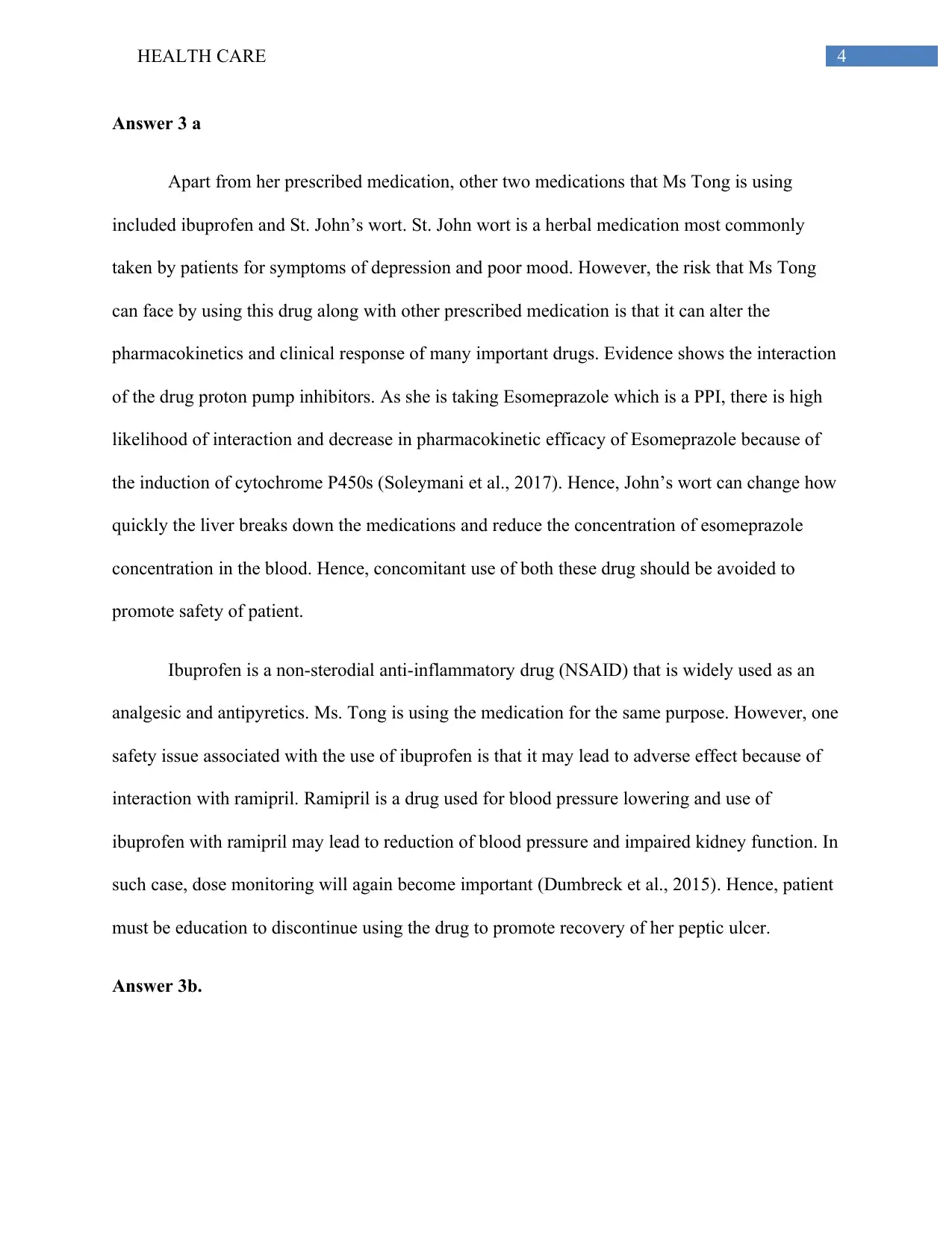
4HEALTH CARE
Answer 3 a
Apart from her prescribed medication, other two medications that Ms Tong is using
included ibuprofen and St. John’s wort. St. John wort is a herbal medication most commonly
taken by patients for symptoms of depression and poor mood. However, the risk that Ms Tong
can face by using this drug along with other prescribed medication is that it can alter the
pharmacokinetics and clinical response of many important drugs. Evidence shows the interaction
of the drug proton pump inhibitors. As she is taking Esomeprazole which is a PPI, there is high
likelihood of interaction and decrease in pharmacokinetic efficacy of Esomeprazole because of
the induction of cytochrome P450s (Soleymani et al., 2017). Hence, John’s wort can change how
quickly the liver breaks down the medications and reduce the concentration of esomeprazole
concentration in the blood. Hence, concomitant use of both these drug should be avoided to
promote safety of patient.
Ibuprofen is a non-sterodial anti-inflammatory drug (NSAID) that is widely used as an
analgesic and antipyretics. Ms. Tong is using the medication for the same purpose. However, one
safety issue associated with the use of ibuprofen is that it may lead to adverse effect because of
interaction with ramipril. Ramipril is a drug used for blood pressure lowering and use of
ibuprofen with ramipril may lead to reduction of blood pressure and impaired kidney function. In
such case, dose monitoring will again become important (Dumbreck et al., 2015). Hence, patient
must be education to discontinue using the drug to promote recovery of her peptic ulcer.
Answer 3b.
Answer 3 a
Apart from her prescribed medication, other two medications that Ms Tong is using
included ibuprofen and St. John’s wort. St. John wort is a herbal medication most commonly
taken by patients for symptoms of depression and poor mood. However, the risk that Ms Tong
can face by using this drug along with other prescribed medication is that it can alter the
pharmacokinetics and clinical response of many important drugs. Evidence shows the interaction
of the drug proton pump inhibitors. As she is taking Esomeprazole which is a PPI, there is high
likelihood of interaction and decrease in pharmacokinetic efficacy of Esomeprazole because of
the induction of cytochrome P450s (Soleymani et al., 2017). Hence, John’s wort can change how
quickly the liver breaks down the medications and reduce the concentration of esomeprazole
concentration in the blood. Hence, concomitant use of both these drug should be avoided to
promote safety of patient.
Ibuprofen is a non-sterodial anti-inflammatory drug (NSAID) that is widely used as an
analgesic and antipyretics. Ms. Tong is using the medication for the same purpose. However, one
safety issue associated with the use of ibuprofen is that it may lead to adverse effect because of
interaction with ramipril. Ramipril is a drug used for blood pressure lowering and use of
ibuprofen with ramipril may lead to reduction of blood pressure and impaired kidney function. In
such case, dose monitoring will again become important (Dumbreck et al., 2015). Hence, patient
must be education to discontinue using the drug to promote recovery of her peptic ulcer.
Answer 3b.
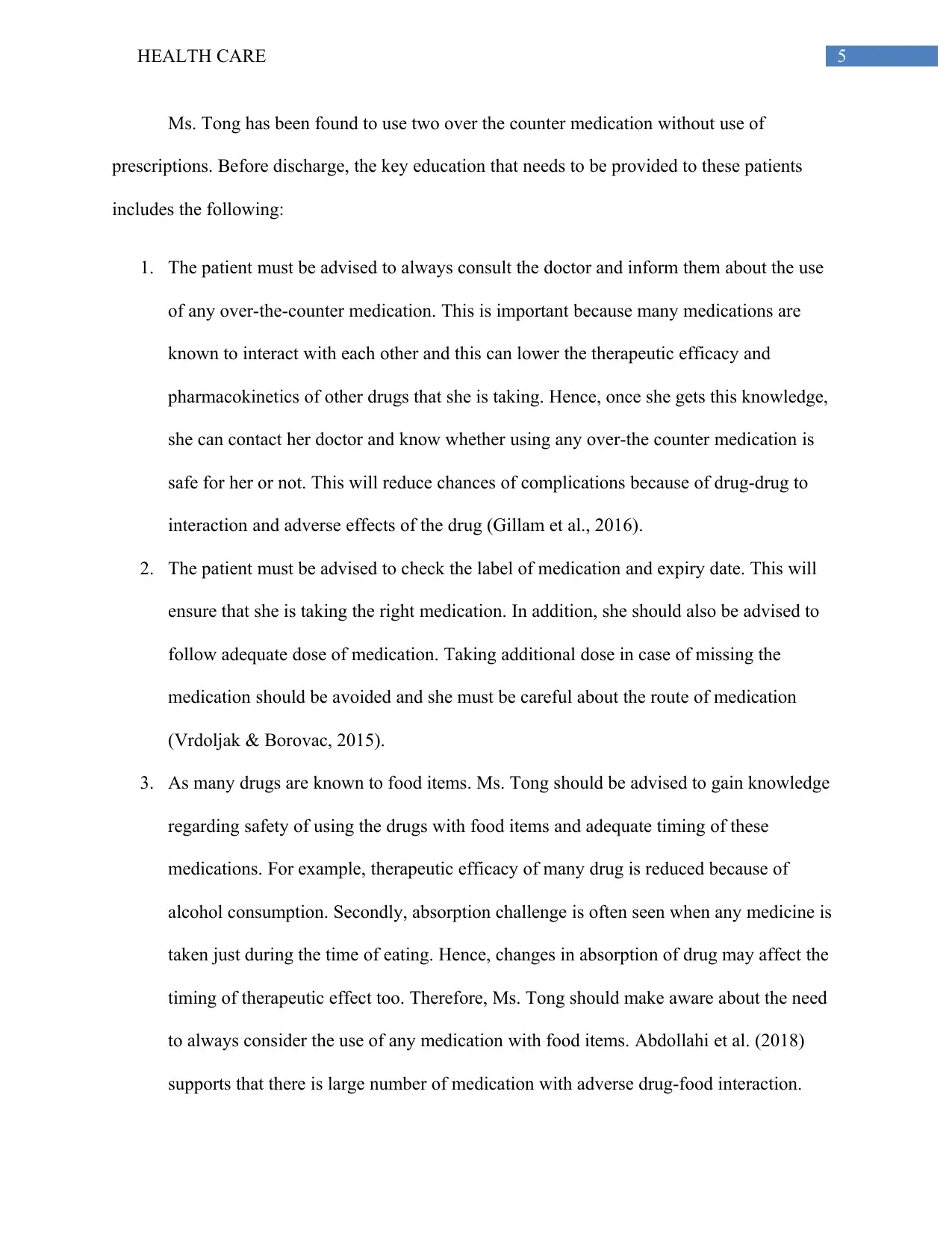
5HEALTH CARE
Ms. Tong has been found to use two over the counter medication without use of
prescriptions. Before discharge, the key education that needs to be provided to these patients
includes the following:
1. The patient must be advised to always consult the doctor and inform them about the use
of any over-the-counter medication. This is important because many medications are
known to interact with each other and this can lower the therapeutic efficacy and
pharmacokinetics of other drugs that she is taking. Hence, once she gets this knowledge,
she can contact her doctor and know whether using any over-the counter medication is
safe for her or not. This will reduce chances of complications because of drug-drug to
interaction and adverse effects of the drug (Gillam et al., 2016).
2. The patient must be advised to check the label of medication and expiry date. This will
ensure that she is taking the right medication. In addition, she should also be advised to
follow adequate dose of medication. Taking additional dose in case of missing the
medication should be avoided and she must be careful about the route of medication
(Vrdoljak & Borovac, 2015).
3. As many drugs are known to food items. Ms. Tong should be advised to gain knowledge
regarding safety of using the drugs with food items and adequate timing of these
medications. For example, therapeutic efficacy of many drug is reduced because of
alcohol consumption. Secondly, absorption challenge is often seen when any medicine is
taken just during the time of eating. Hence, changes in absorption of drug may affect the
timing of therapeutic effect too. Therefore, Ms. Tong should make aware about the need
to always consider the use of any medication with food items. Abdollahi et al. (2018)
supports that there is large number of medication with adverse drug-food interaction.
Ms. Tong has been found to use two over the counter medication without use of
prescriptions. Before discharge, the key education that needs to be provided to these patients
includes the following:
1. The patient must be advised to always consult the doctor and inform them about the use
of any over-the-counter medication. This is important because many medications are
known to interact with each other and this can lower the therapeutic efficacy and
pharmacokinetics of other drugs that she is taking. Hence, once she gets this knowledge,
she can contact her doctor and know whether using any over-the counter medication is
safe for her or not. This will reduce chances of complications because of drug-drug to
interaction and adverse effects of the drug (Gillam et al., 2016).
2. The patient must be advised to check the label of medication and expiry date. This will
ensure that she is taking the right medication. In addition, she should also be advised to
follow adequate dose of medication. Taking additional dose in case of missing the
medication should be avoided and she must be careful about the route of medication
(Vrdoljak & Borovac, 2015).
3. As many drugs are known to food items. Ms. Tong should be advised to gain knowledge
regarding safety of using the drugs with food items and adequate timing of these
medications. For example, therapeutic efficacy of many drug is reduced because of
alcohol consumption. Secondly, absorption challenge is often seen when any medicine is
taken just during the time of eating. Hence, changes in absorption of drug may affect the
timing of therapeutic effect too. Therefore, Ms. Tong should make aware about the need
to always consider the use of any medication with food items. Abdollahi et al. (2018)
supports that there is large number of medication with adverse drug-food interaction.

6HEALTH CARE
Hence, education in this area will help Ms. Tong to take adequate quantity of drug with
proper quantity of food and at suitable time. Communicating with caregivers regarding usage
of any medication is critical for patient safety as it reduces the possibility of adverse effects,
poor clinical outcome and unnecessary hospitalization.
Hence, education in this area will help Ms. Tong to take adequate quantity of drug with
proper quantity of food and at suitable time. Communicating with caregivers regarding usage
of any medication is critical for patient safety as it reduces the possibility of adverse effects,
poor clinical outcome and unnecessary hospitalization.
Paraphrase This Document
Need a fresh take? Get an instant paraphrase of this document with our AI Paraphraser
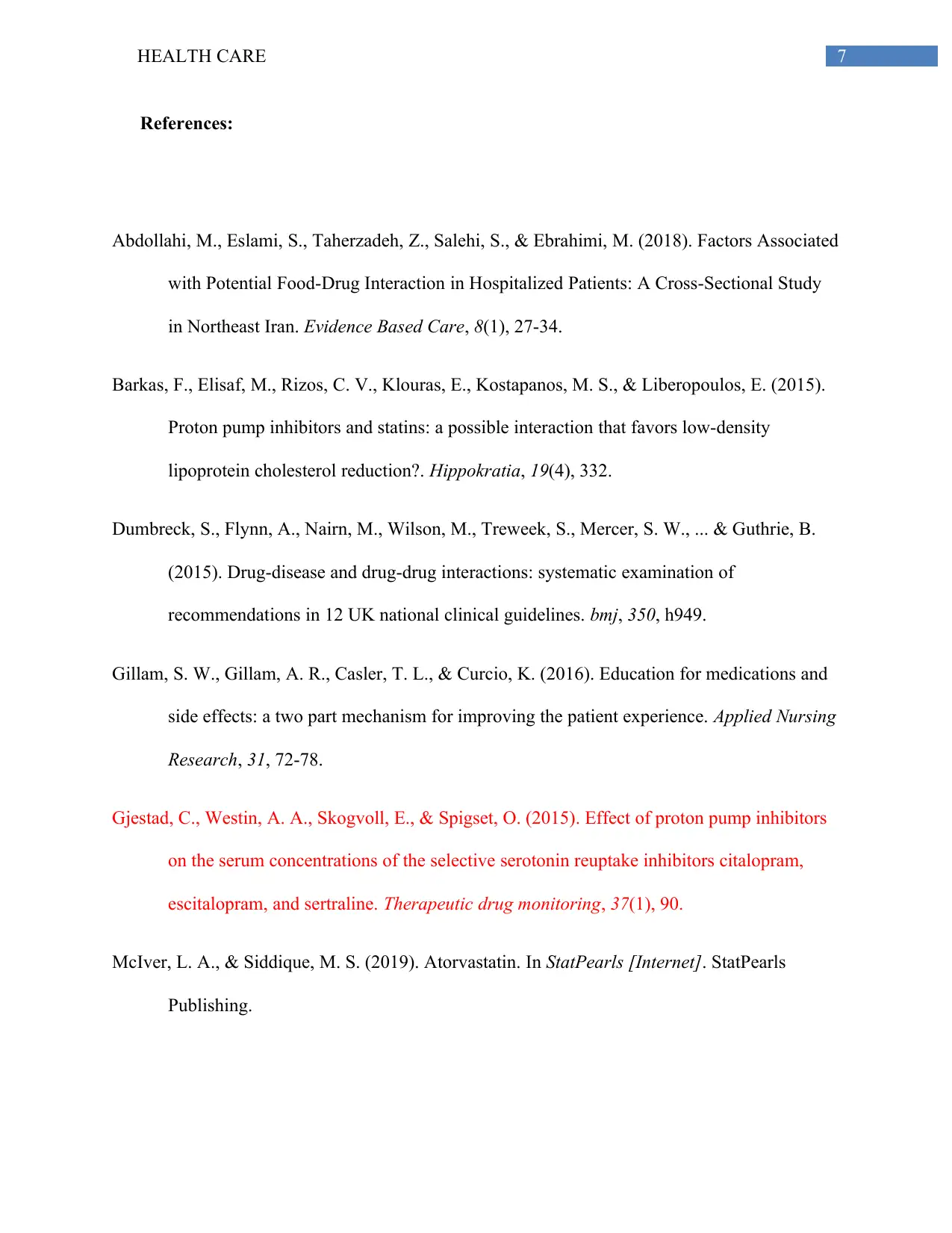
7HEALTH CARE
References:
Abdollahi, M., Eslami, S., Taherzadeh, Z., Salehi, S., & Ebrahimi, M. (2018). Factors Associated
with Potential Food-Drug Interaction in Hospitalized Patients: A Cross-Sectional Study
in Northeast Iran. Evidence Based Care, 8(1), 27-34.
Barkas, F., Elisaf, M., Rizos, C. V., Klouras, E., Kostapanos, M. S., & Liberopoulos, E. (2015).
Proton pump inhibitors and statins: a possible interaction that favors low-density
lipoprotein cholesterol reduction?. Hippokratia, 19(4), 332.
Dumbreck, S., Flynn, A., Nairn, M., Wilson, M., Treweek, S., Mercer, S. W., ... & Guthrie, B.
(2015). Drug-disease and drug-drug interactions: systematic examination of
recommendations in 12 UK national clinical guidelines. bmj, 350, h949.
Gillam, S. W., Gillam, A. R., Casler, T. L., & Curcio, K. (2016). Education for medications and
side effects: a two part mechanism for improving the patient experience. Applied Nursing
Research, 31, 72-78.
Gjestad, C., Westin, A. A., Skogvoll, E., & Spigset, O. (2015). Effect of proton pump inhibitors
on the serum concentrations of the selective serotonin reuptake inhibitors citalopram,
escitalopram, and sertraline. Therapeutic drug monitoring, 37(1), 90.
McIver, L. A., & Siddique, M. S. (2019). Atorvastatin. In StatPearls [Internet]. StatPearls
Publishing.
References:
Abdollahi, M., Eslami, S., Taherzadeh, Z., Salehi, S., & Ebrahimi, M. (2018). Factors Associated
with Potential Food-Drug Interaction in Hospitalized Patients: A Cross-Sectional Study
in Northeast Iran. Evidence Based Care, 8(1), 27-34.
Barkas, F., Elisaf, M., Rizos, C. V., Klouras, E., Kostapanos, M. S., & Liberopoulos, E. (2015).
Proton pump inhibitors and statins: a possible interaction that favors low-density
lipoprotein cholesterol reduction?. Hippokratia, 19(4), 332.
Dumbreck, S., Flynn, A., Nairn, M., Wilson, M., Treweek, S., Mercer, S. W., ... & Guthrie, B.
(2015). Drug-disease and drug-drug interactions: systematic examination of
recommendations in 12 UK national clinical guidelines. bmj, 350, h949.
Gillam, S. W., Gillam, A. R., Casler, T. L., & Curcio, K. (2016). Education for medications and
side effects: a two part mechanism for improving the patient experience. Applied Nursing
Research, 31, 72-78.
Gjestad, C., Westin, A. A., Skogvoll, E., & Spigset, O. (2015). Effect of proton pump inhibitors
on the serum concentrations of the selective serotonin reuptake inhibitors citalopram,
escitalopram, and sertraline. Therapeutic drug monitoring, 37(1), 90.
McIver, L. A., & Siddique, M. S. (2019). Atorvastatin. In StatPearls [Internet]. StatPearls
Publishing.
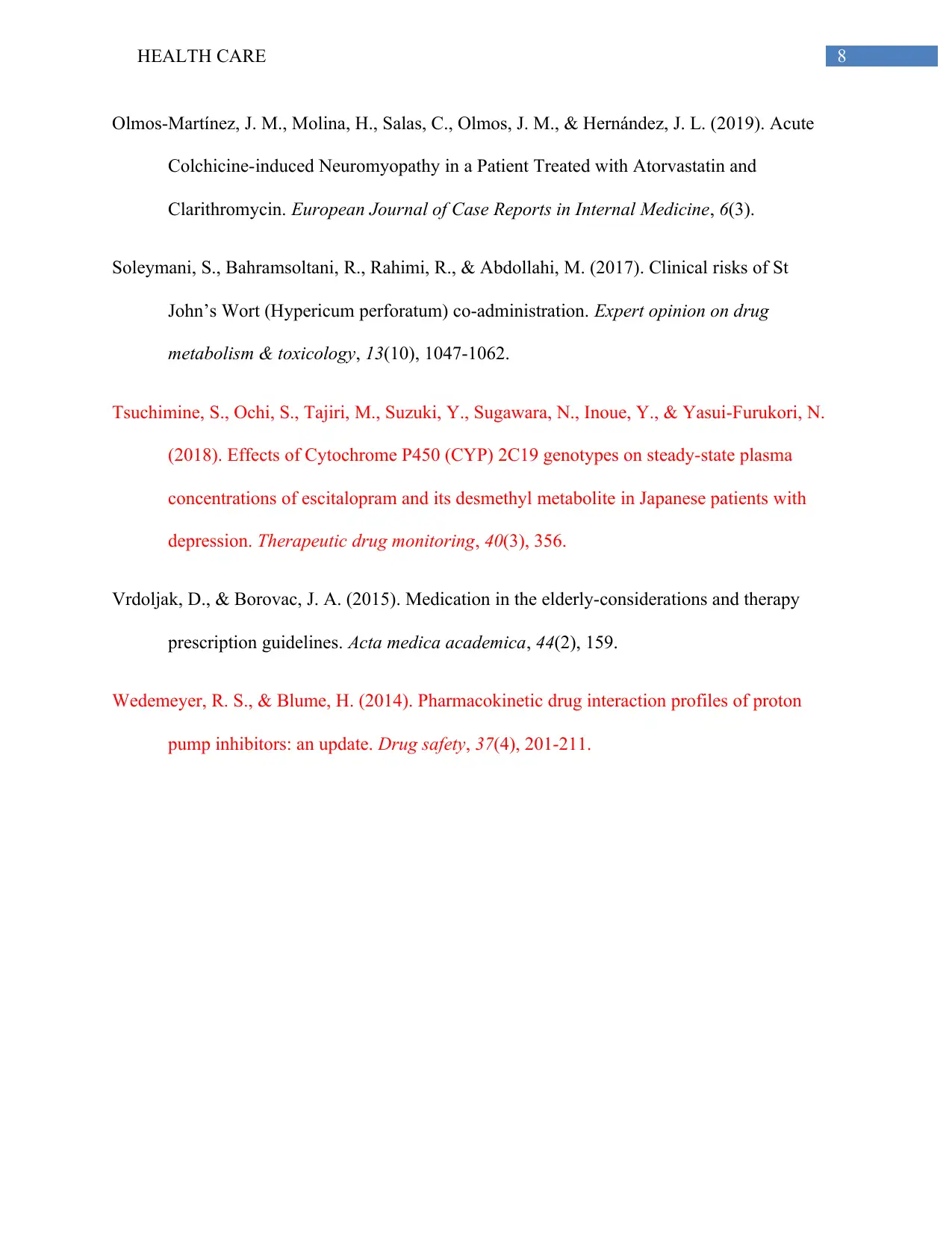
8HEALTH CARE
Olmos-Martínez, J. M., Molina, H., Salas, C., Olmos, J. M., & Hernández, J. L. (2019). Acute
Colchicine-induced Neuromyopathy in a Patient Treated with Atorvastatin and
Clarithromycin. European Journal of Case Reports in Internal Medicine, 6(3).
Soleymani, S., Bahramsoltani, R., Rahimi, R., & Abdollahi, M. (2017). Clinical risks of St
John’s Wort (Hypericum perforatum) co-administration. Expert opinion on drug
metabolism & toxicology, 13(10), 1047-1062.
Tsuchimine, S., Ochi, S., Tajiri, M., Suzuki, Y., Sugawara, N., Inoue, Y., & Yasui-Furukori, N.
(2018). Effects of Cytochrome P450 (CYP) 2C19 genotypes on steady-state plasma
concentrations of escitalopram and its desmethyl metabolite in Japanese patients with
depression. Therapeutic drug monitoring, 40(3), 356.
Vrdoljak, D., & Borovac, J. A. (2015). Medication in the elderly-considerations and therapy
prescription guidelines. Acta medica academica, 44(2), 159.
Wedemeyer, R. S., & Blume, H. (2014). Pharmacokinetic drug interaction profiles of proton
pump inhibitors: an update. Drug safety, 37(4), 201-211.
Olmos-Martínez, J. M., Molina, H., Salas, C., Olmos, J. M., & Hernández, J. L. (2019). Acute
Colchicine-induced Neuromyopathy in a Patient Treated with Atorvastatin and
Clarithromycin. European Journal of Case Reports in Internal Medicine, 6(3).
Soleymani, S., Bahramsoltani, R., Rahimi, R., & Abdollahi, M. (2017). Clinical risks of St
John’s Wort (Hypericum perforatum) co-administration. Expert opinion on drug
metabolism & toxicology, 13(10), 1047-1062.
Tsuchimine, S., Ochi, S., Tajiri, M., Suzuki, Y., Sugawara, N., Inoue, Y., & Yasui-Furukori, N.
(2018). Effects of Cytochrome P450 (CYP) 2C19 genotypes on steady-state plasma
concentrations of escitalopram and its desmethyl metabolite in Japanese patients with
depression. Therapeutic drug monitoring, 40(3), 356.
Vrdoljak, D., & Borovac, J. A. (2015). Medication in the elderly-considerations and therapy
prescription guidelines. Acta medica academica, 44(2), 159.
Wedemeyer, R. S., & Blume, H. (2014). Pharmacokinetic drug interaction profiles of proton
pump inhibitors: an update. Drug safety, 37(4), 201-211.
1 out of 9
Related Documents
Your All-in-One AI-Powered Toolkit for Academic Success.
+13062052269
info@desklib.com
Available 24*7 on WhatsApp / Email
![[object Object]](/_next/static/media/star-bottom.7253800d.svg)
Unlock your academic potential
© 2024 | Zucol Services PVT LTD | All rights reserved.





